About problem:
Which job offer to accept due to the number of more or less standard
criteria is dilemma that is often found with freelancers (and with
other employees, of course, but in this paper focuses primarily on the
specifics of freelancers).
Often, the same people can meet on various projects and have the opportunity
to exchange experiences related to a variety of situations, but still
has access to each individual situation that is significantly different for
each participant: this kind of work is quite subjectively determined.
It often is difficult to hear two similar position on the same issue,
and especially agreed opinion on a long and complex project.
However, such an exchange of information still provides some insight
into the otherwise unknown state of a project. No matter how certain
information should be taken with caution, a collection of the same
information from different sources can give a picture of the project at
the moment of decision-making, and it knows very often again be of
significant help. The fact is that, really, the decision in such
situations is a compilation of anticipated consequences of thus
obtained information
Looking subsequent to such a decision, it turns out that they are
largely dependent on the share of each input in fully created
image of the project that we have been thinking of.. The question
is what would happen if the particular information had given greater or
lesser importance, or that their interactions had differently valued.
Solutions:
A set of alternative solutions in this case consists of a variety of
business opportunities. I'll call them Solution 1 (Sol1) Solution 2 (Sol2) ...
Each solution has its own characteristics which will be discussed later. These characteristics are more or less attractive,
but none of them have a distinct advantage in all of them.
Solution 1:
Job in Copenhagen, obligatory presence at the employer place,code in a
relatively good shape but too small volume (estimated a month).
Solution 2:
Job in Graz, obligatory presence at the employer place, code in good
condition, estimate the job volume of approximately 3 months. Labour costs
very little.
Solution 3:
Business in Zagreb, compulsory presence at the employer's assessment ,
the job duration about one month, information about the job are good, the
price of labor is very good.
Solution 4:
Business in Rome, compulsory presence at the employer's assessment, code in a very
good condition but too small volume (estimated a month). Also known
employer, previous cooperation was excellent.
Solution 5:
Job in London, it is not required to be present at the employer after a
certain period, code in poor condition and too small (estimated a
month). Information about the job and bad as well as the infgormation of the employer.
Solution 6:
Job in Zurich, compulsory presence at the employer place, code in the relatively
good condition and of good volume (estimated at 3 to 4 months). Known
associates, bad experiences with them.
Determination of the criteria set:
It is not a problem to identify the criteria that are
important for evaluating the solution: they are generally noticeable
and clear. However, their interrelationships are not expected to
show themselves, especially they are not easily measured.
Compromises in defining criteria can influence the decision, but if
we start from the assumption that in fact we consider only the problem
defined with those criteria, it is easier to change the criteria to define
different problems than try them all reduce to the same "common
denominator". The set of similar problems still have common roots, so
that family problems can be reduced to different impacts of changing
the criteria.
Even Swaps that impacts has addressed in
different ways.
It is not irrelevant which attribute is to be replaced, and with which one will be
replaced.
Criteria:
LOCATIONS
Zagreb,
Graz, Rome, Copenhagen, London...
Stacked to the desirability of the most desirable destinations to the
least interesting. What is a city farther the costs are higher.
There are still important accommodation costs, as well as the
possible complications of a formalization of one kind or anozher... Scale 1-9.
CODE STATE
An important criterion for taking a business. Here is the situation
illustrated with the scale of 1-9.
ENGAGEMENT PERIOD
Good-Poor
Complicated: sometimes less is more preferable, sometimes not with the same
majority of these criteria. In order not to have introduced new criteria, duration is
limited to a preset conclusion: 1 or is 0.
ASSOCIATES
Scale 1-9
ADMINISTRATION
Scale 1-9
MAINTENANCE
Yes-No, that is 1 or is 0.
DEADLINE
No-Yes. 1-0.
Answers the question of whether the engagement is organized through the
defined timeframe for the completion of certain phases, or the entire
project. Dead-line is in principle undesirable.
INFORMATION
Scale 1-9.
Refers to information about the project. Sometimes it is not important,
but once again could help ...
FEE
Scale 1-9.
REMOTE
Yes-No, 1-0.
Refers to the ability to work from a remote location. The most
desirable characteristics of a possible engagement whose importance is
reflected in the compensation value.
Software:
Homepage:

-
Archives issues relating to the saved situation. JOBSEARCH l is an example
of this work.
- New problem allows the creation of new situations.
Archives:

Clicking on the name of the problem goes to the already defined
problems.
JOBSEARCH:
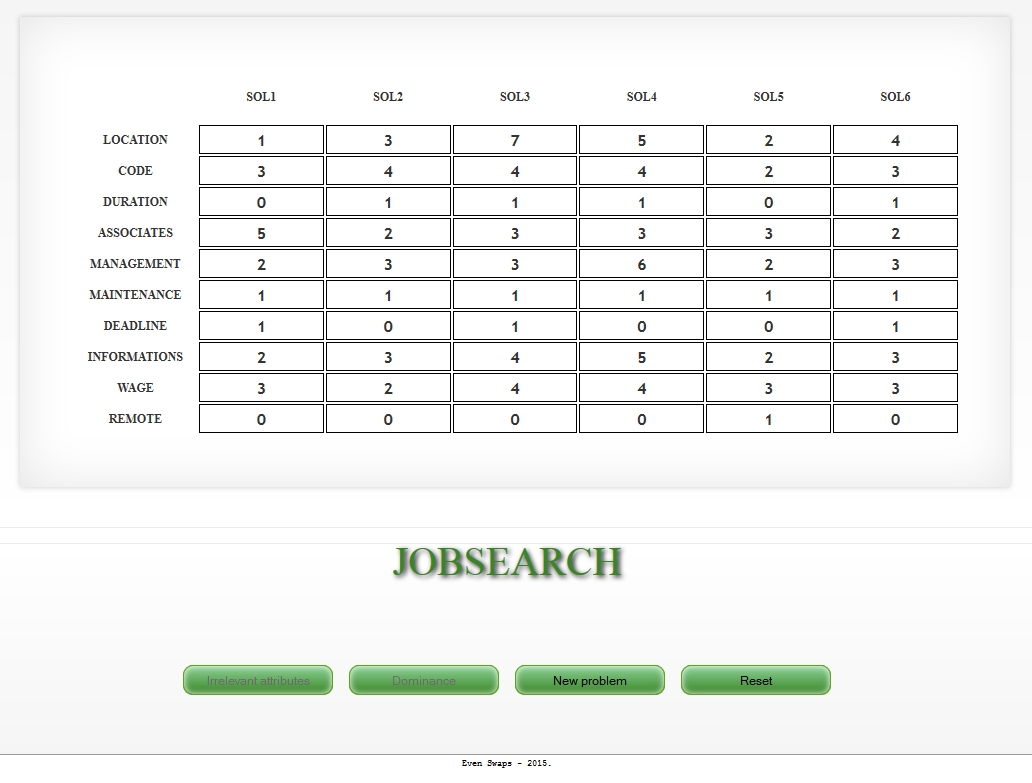
We would be back on that situation later. Now click on New problem in order to create new situation. Here will be presented creation of exposed JOBSEARCH problem.
New problem:
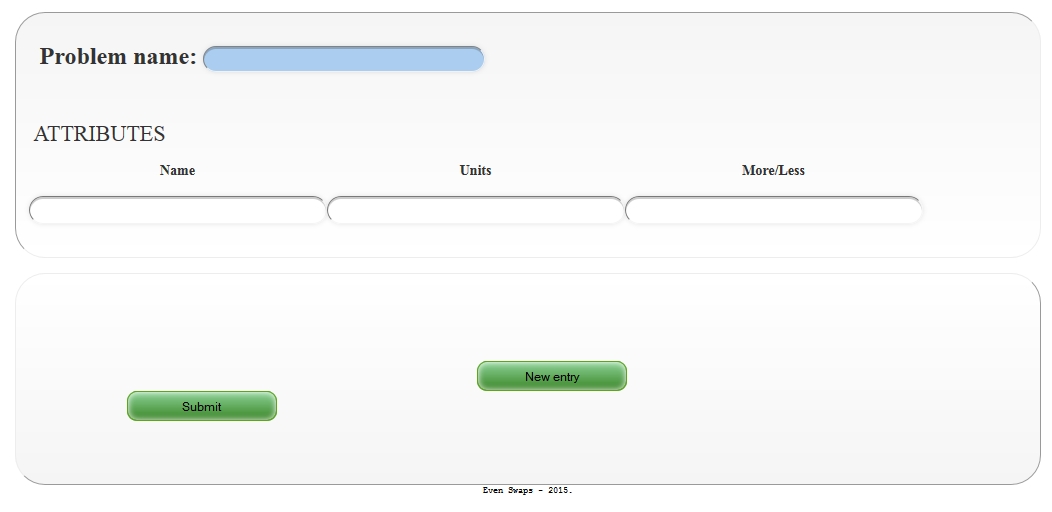
First
we define the name of problem, then criteria, the unit of measure to
which it relates, and the method of measurement: the more is better, or
less is better.
For JOBSEARCH it looks this way, Criteria definition:
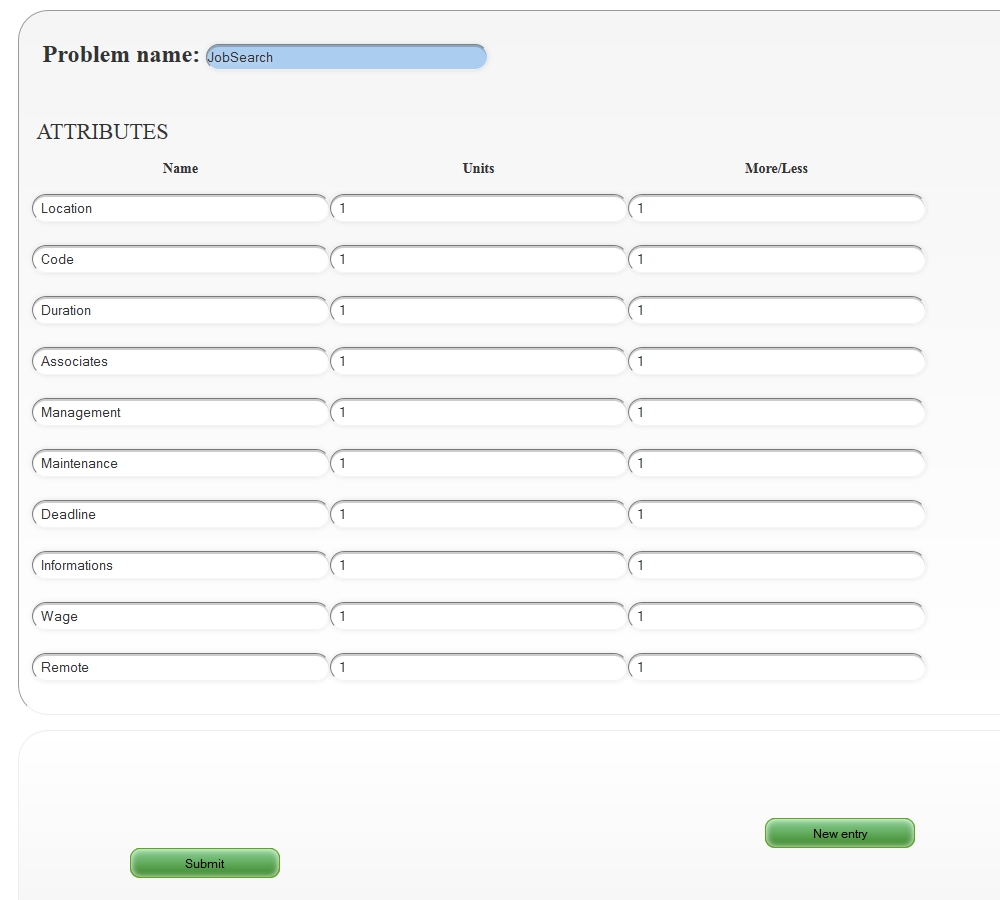
It
is possible, of course, measure Location in hundreds of
kilometers, or Compensation in thousands of dollars, or whatever
decision maker believes that it is easier.
In this example it has
been chosen the simplest approach: in any case the interrelationships
compensation table must be defined, so it was easier to think how much
the total range of the locations (1-9) holds a particular fee which is
also a range of 1-9.
After criteria generate solutions:
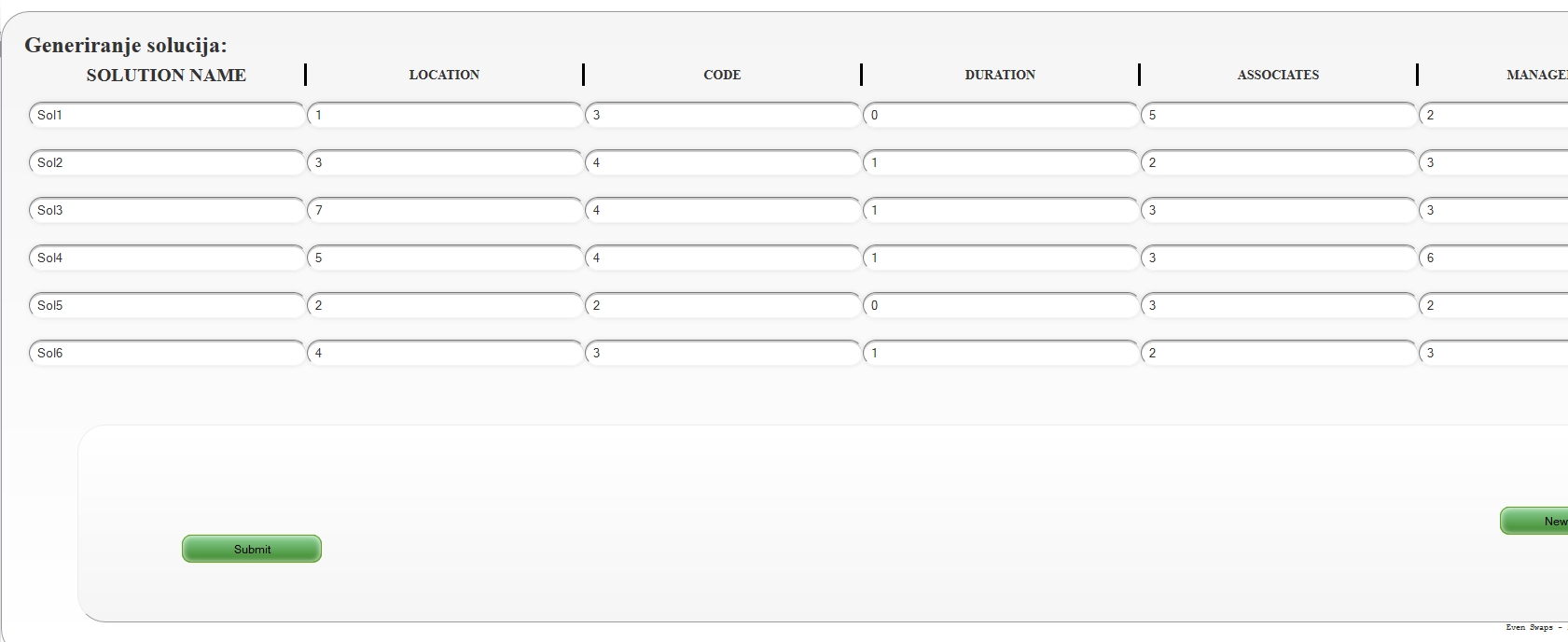
The
program will sort at the top row all the attributes that we defined,
and make possible to generate an arbitrary number of solutions that use
them.
Secon part of generate solutions:
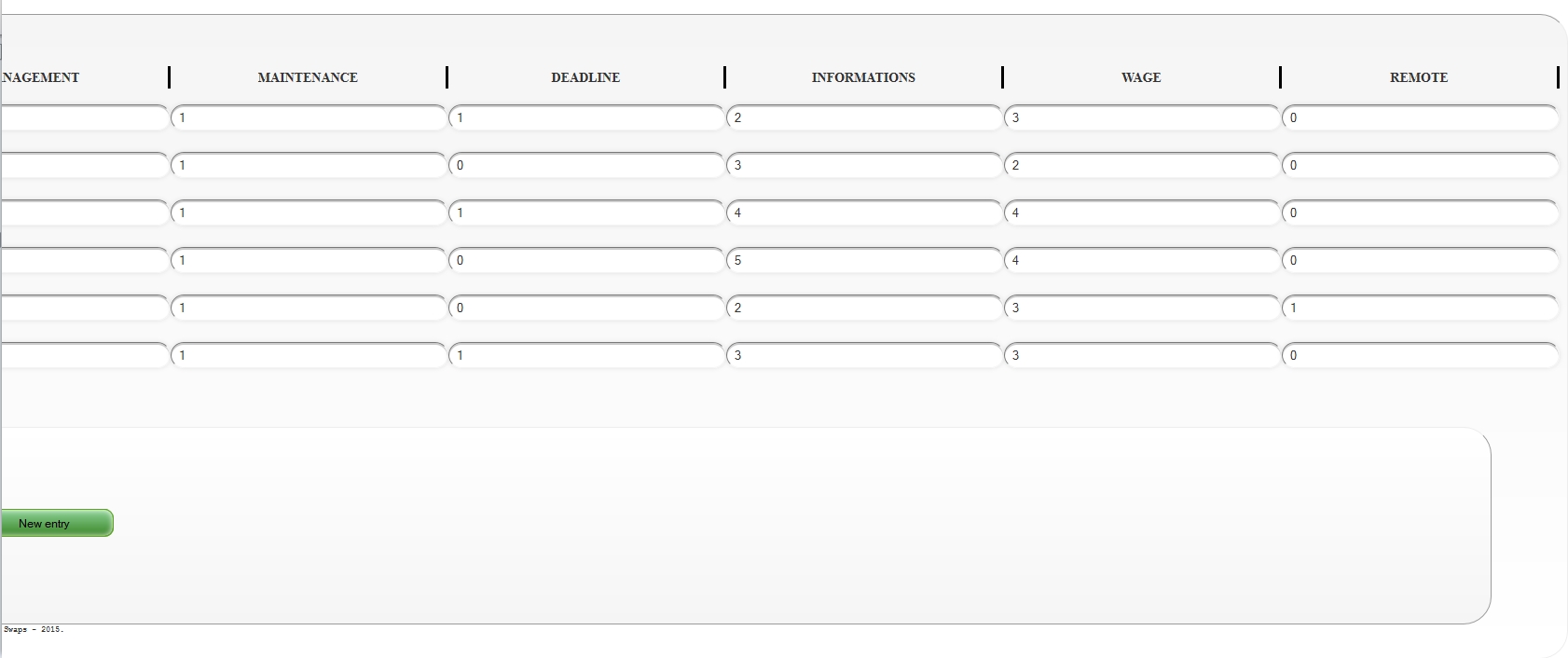
By
generating solutions has been used scale or 1-9, or "binary" 0-1.
For this and similar case it is sufficient range, and the solutions are
similar to the situation that could be set when using the AHP for
example, so it make comparable situation. The real problem is the
relationship with the replacement of which is defined compensation
table:
Compensation table:
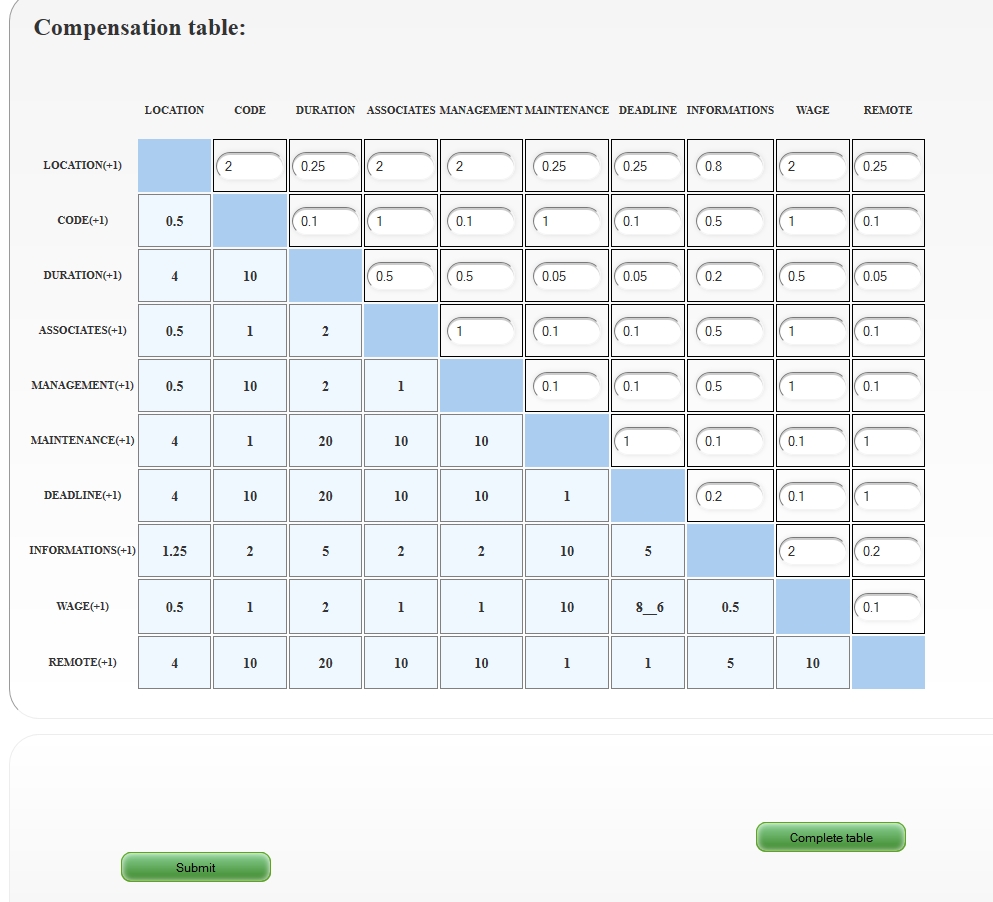
Everything
that is entered from the top diagonal will automatically appear in
their reciprocal form and in the appropriate place on the underside of
the diagonal.
So STATE CODE / LOCATION = 2 the same as LOCATION / STATE CODE = 0.5.
Interesting is the "binary" REMOTE. This is a very important criterion since it is a job that lets you work remotely. Hence these relations in compensation: DURATION / REMOTE = 20. The nature of this criterion and is "binary" (yes / no), but only after the compensation criteria it is visible to what extent is important.
Compensation criteria may be negative. Thus the ratio of improvising over / under.
Now back to usage of defined JOBSEARCH:

- Reset
means that the replacements are returning to the starting point, on the
situation in which we find ourselves when we came to a defined problem.
- New problem
(new issue) means that we give up of the replacement of the solutions
for chosen problem and we want to work on another problem or define a
new problem. This leads to the very beginning of the program.
- Irrelevant attributes
related to the situation in which the decision maker decided to do one
of the attributes irrelevant. It needs to be labeled, and then choose
compensatory attribute.
- Domination
includes both types of domination at the moment. To make
dominated some solution decision maker need to click
on it. It becomes orange and button for dominance becomes usable.
We'll explain in detail all of above mentioned.
Select
the DURATION for irrelevant attributes and REMOTE for compensation. The
program will detect MAINTENANCE as irrelevant, so that at the end of
this happens:
Step1, click on DURATION:
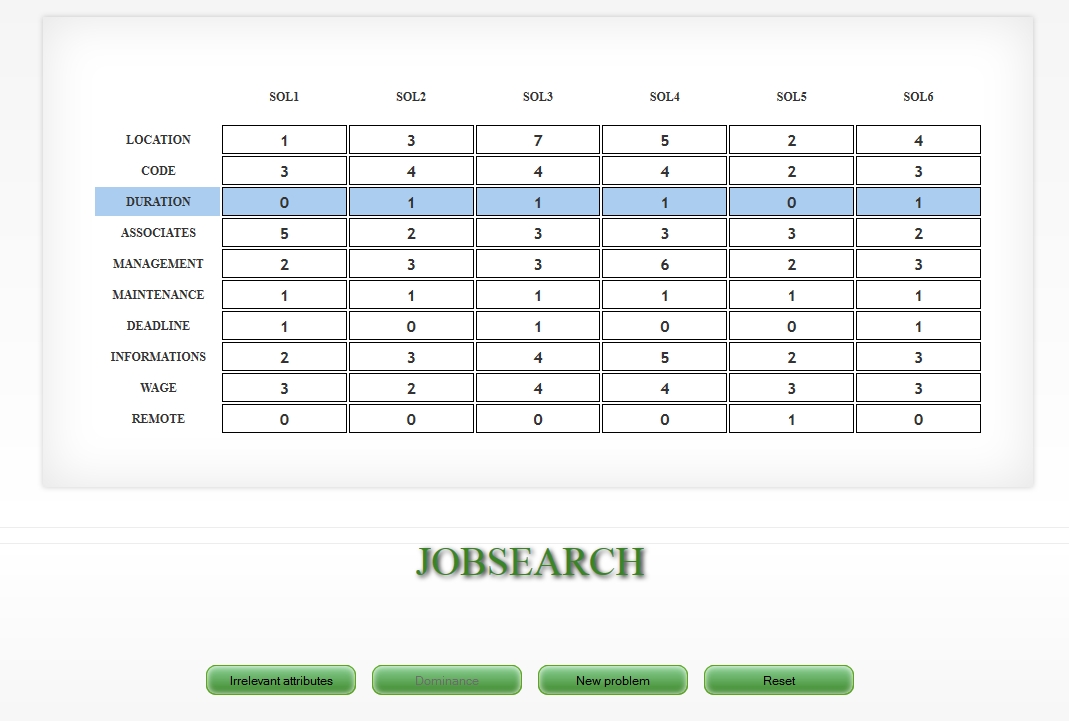
Now click on Irrelevant attributes, confirm that click and program will ask for compensatory attribute:
Step2:
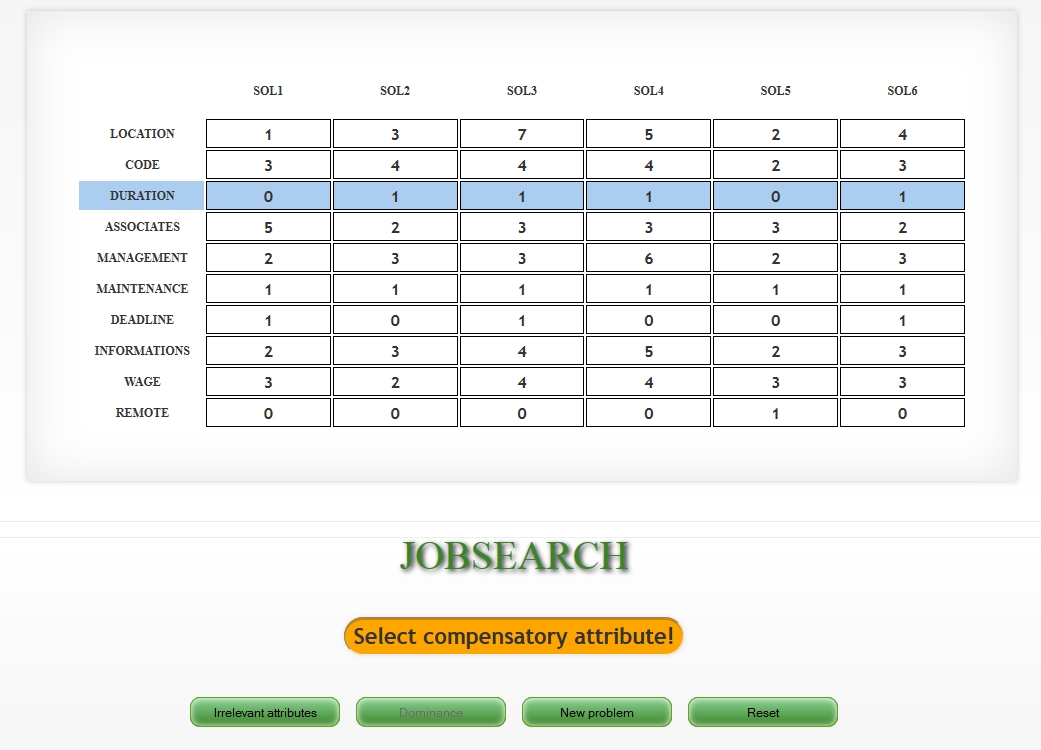
Choose REMOTE and rhis will happen:
Step 3:
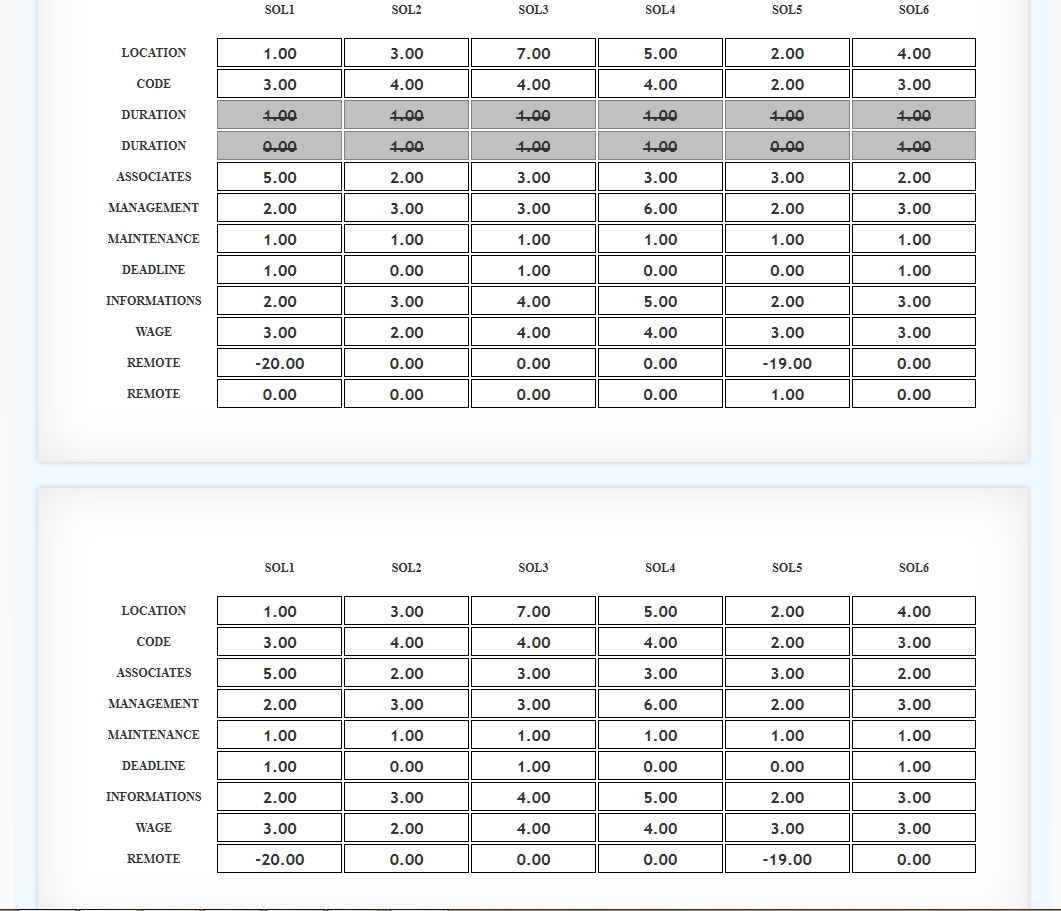
Program will show 4 tables, one by another. Lets see what we have in first two.
At the first table appearing twice two columns. It is a double printing irrelevant and compensating attributes.
In
the same place where there was a DURATION appears another such line,
provided that it contains the mean of DURATION. Now it's easy to
compare and see what the difference in a particular solution to the
mean.
On the same place where he was REMOTE there is also
by compensation reduced REMOTE either . Now it's easy to compare and
see that the SOL1, for example, DURATION increase by 1 resulting
in a reduction of the REMOTE for 20, as defined in the compensation
table.
Second table shows situation without DURATION and with reduced REMOTE ready for new actions.
Now
make closer look at above table. MAINTENANCE is irrelevant by itself
(same for all solutions, so do not have any influence). Program also
recognize that and by itself performs elimination of irrelevant
attribute:
Step 3a:
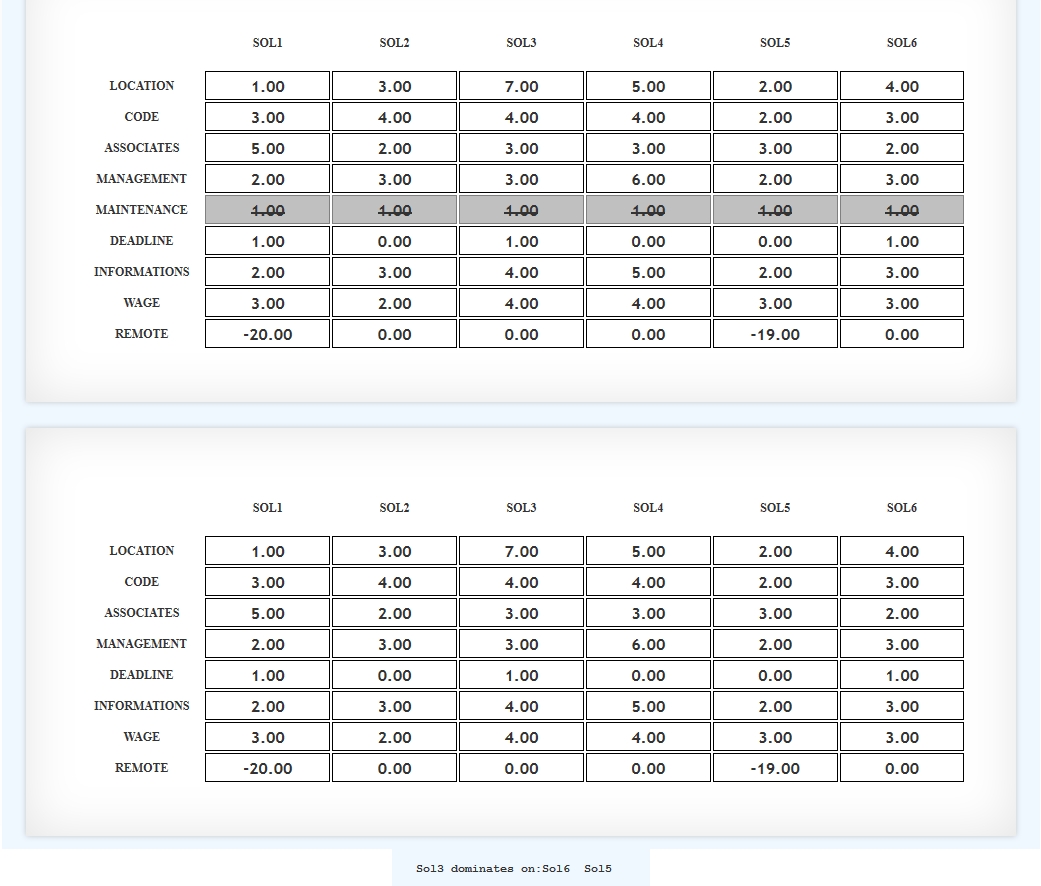
Program marks what is irrelevant and also provide table without it.
Program
also suggests that SOL3 dominate over SOL6 i SOL5. That mean every
criteria of SOL1 is better or same compared with appropriate in SOL6
and SOL5. Practically it means that those two solutions does not
need to exists any more (and this is goal of method) so we can remove
them in our searching for the best solution.
So, click on SOL5. It'll become orange:
Step 4:
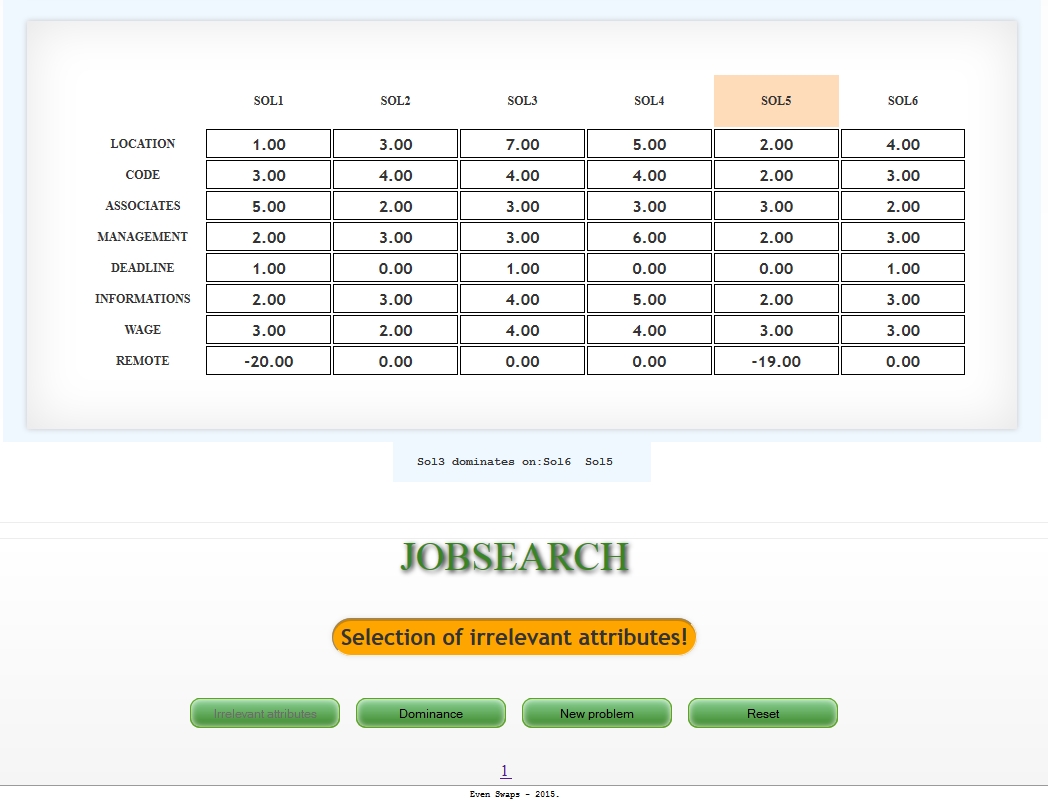
Button Dominance becomes usable. Click on it:
Step 5:
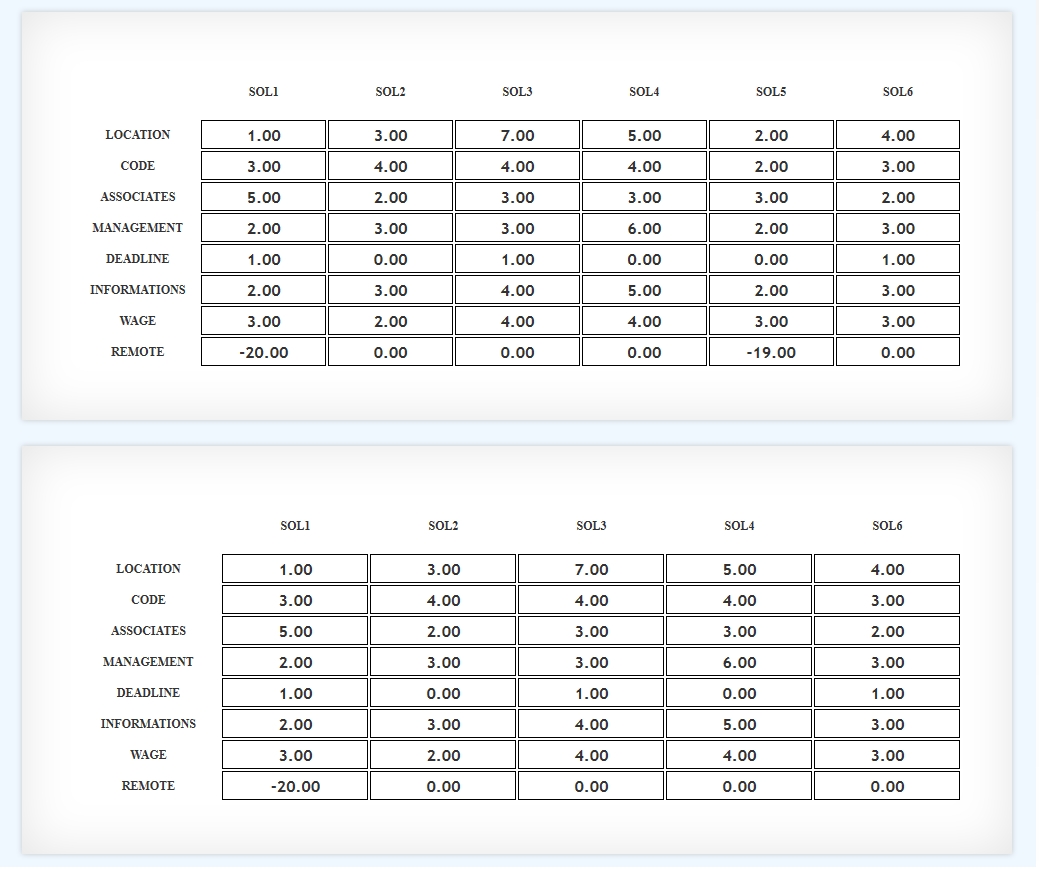
Program will show situation with SOL5 and without it. Do the same with SOL6. What will remain is here:
Step 6:
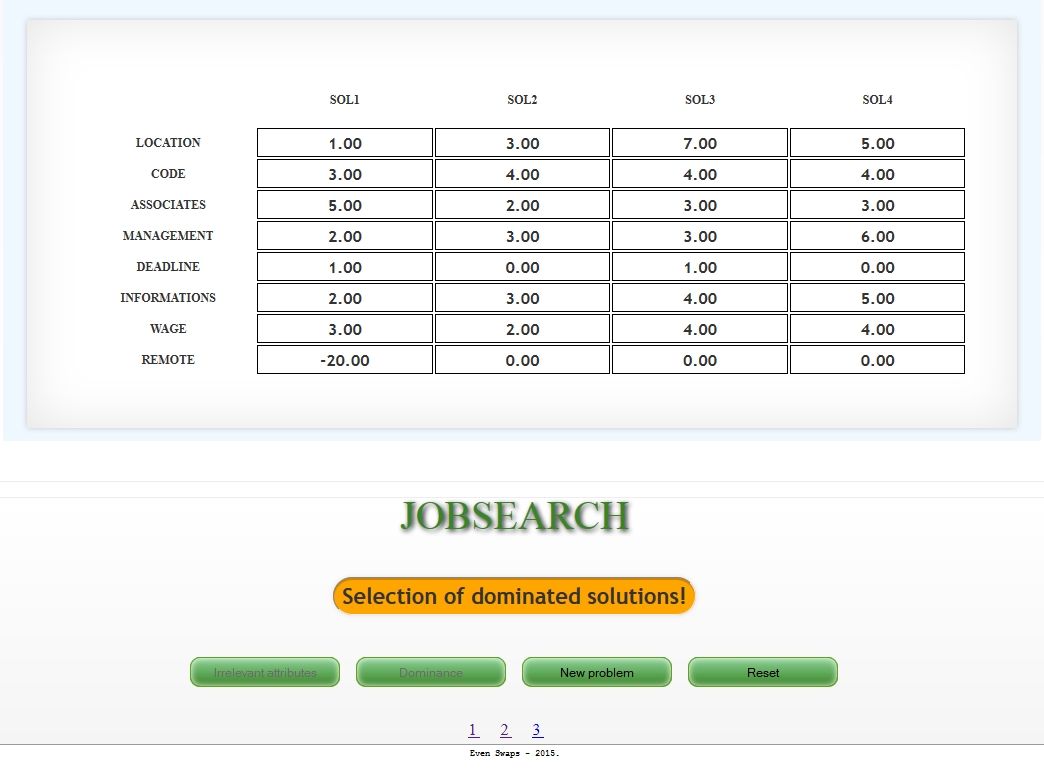
We
have made 3 general actions, and it is possible to change our mind at
this stage. So, if we want to go back through performed actions we
could click on steps number at the bottom of the screen. Click on 1
will make situation like this:
Step 7:
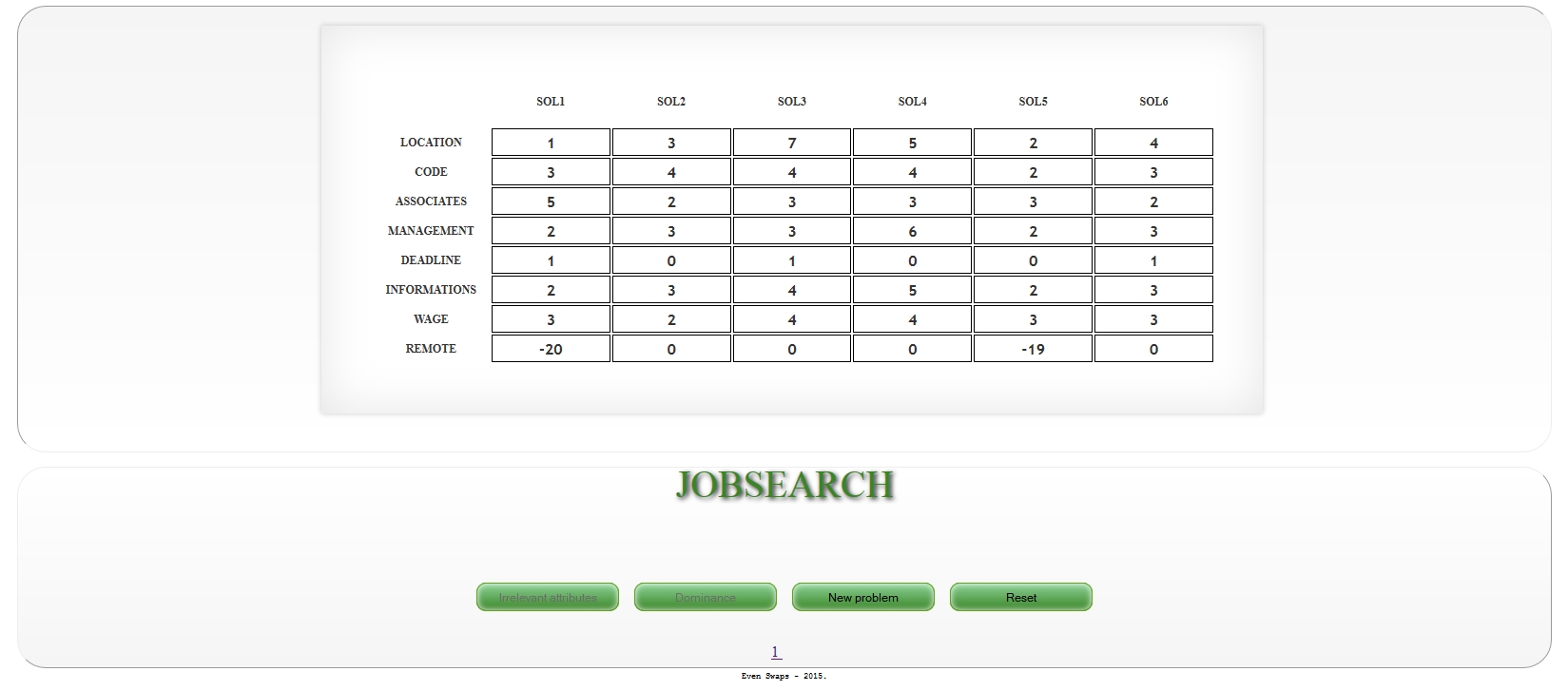
Now we have SOL5 and SOL6 back on screen. If we want completely to back situation on first point, click Reset:
Step 8:
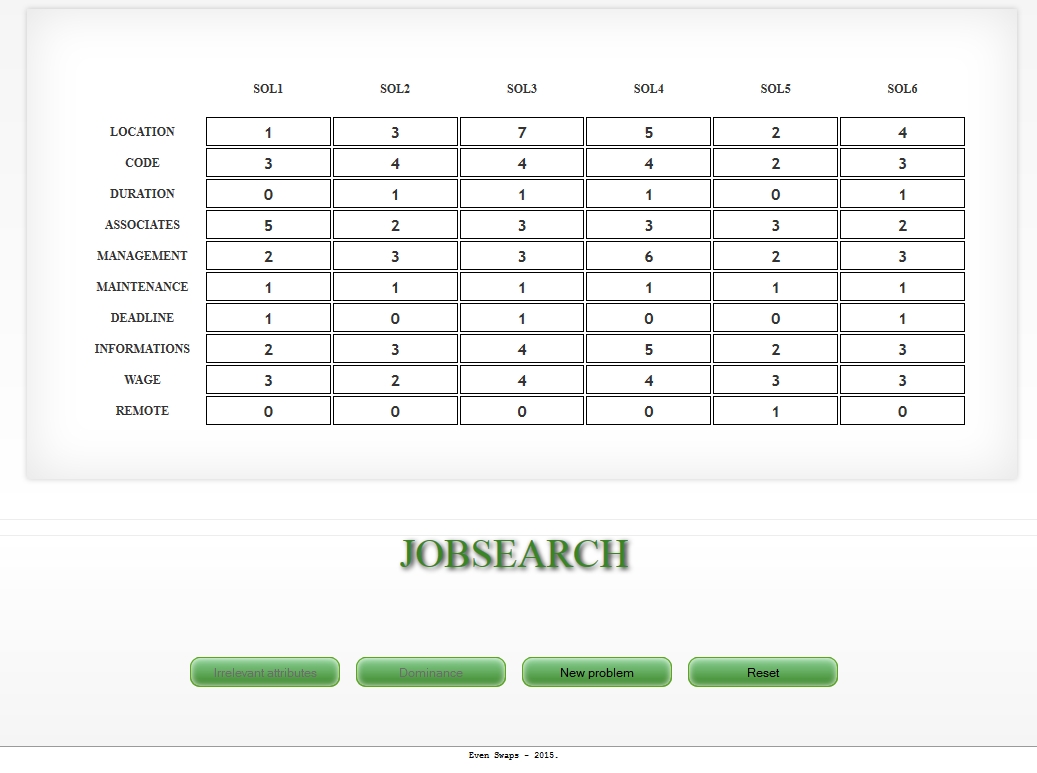
Now we are at the very beginning of our best solution search...
Consider this search path at JOBSEARCH problem:
- Irrelevant DURATION compensatory REMOTE. SOL3 dominated over SOL2 , SOL5 i SOL6.
- Irrelevant REMOTE compensatory ASSOCIATES.
This is going to happen:
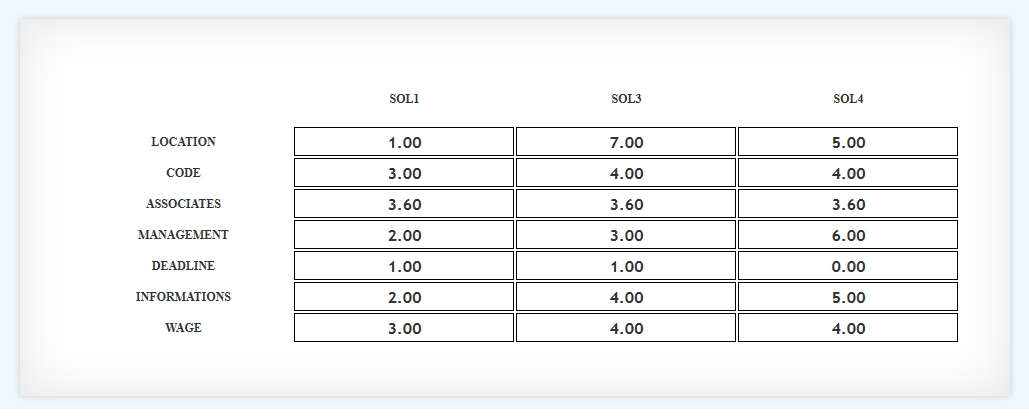
When
REMOTE reduced to 6 (ceil (20/3)), and by compensation table compensate
ASSOCIATES, will turn out that every solution value for ASSOCIATES is
3.6. This means that because of compensatom and ASSOCIATES have become
irrelevant too, and is dominated by SOL1 and SOL3.
Moving
Sol1 will make a chain reaction with your CODE and WAGE so program
will, one by one, show eight tables that represent that process.
Last one:

After all of that we need just one itteration to figure out that SOL4 is the best ...



















